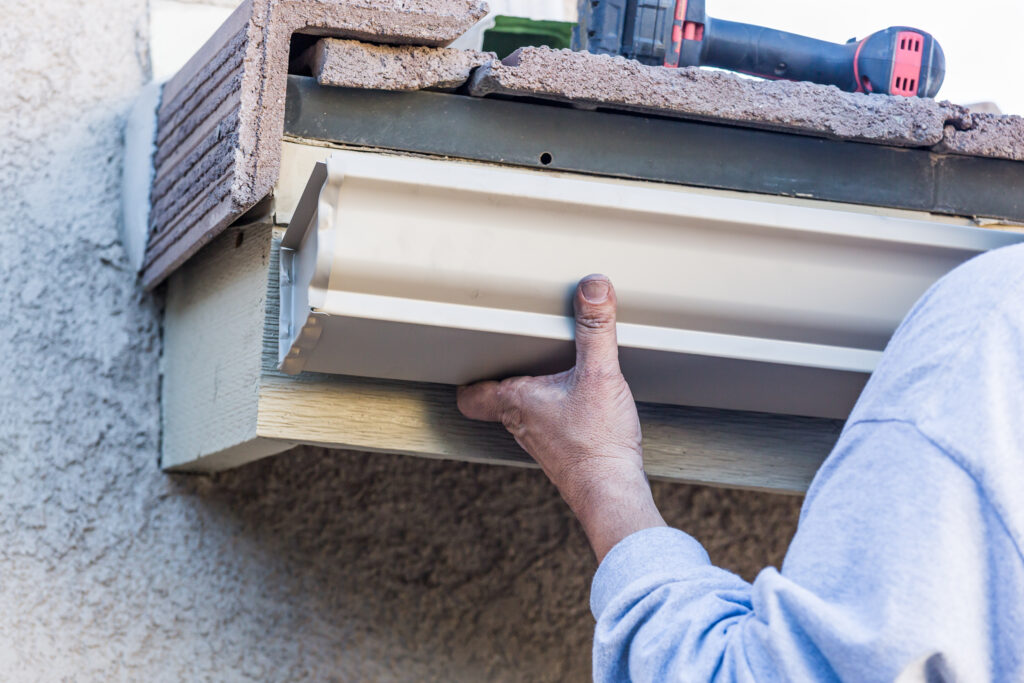Gutters are an integral part of any home’s drainage system, channeling rainwater away from the roof and foundation to prevent water damage. However, they can quickly become clogged with debris such as leaves, twigs, and dirt, leading to blockages and water overflow.
This not only compromises the functionality of the gutters but also poses potential risks to the structural integrity of the property. Leaf guard systems offer a solution to this problem by effectively preventing debris from entering and clogging the gutters. In this blog post, we will explore how leaf guard systems work and the benefits they provide in protecting your gutters from debris.
Understanding Leaf Guard Systems

Leaf guard systems, also known as gutter guards or gutter covers, are devices installed over gutters to prevent debris from entering while allowing water to flow freely. These systems come in various designs and materials, including mesh screens, solid covers, foam inserts, and brush guards. The primary purpose of leaf guard systems is to maintain the functionality of gutters by keeping them clear of debris buildup.
How Leaf Guard Systems Protect Gutters from Debris
- Debris Prevention: The main function of leaf guard systems is to create a barrier that prevents leaves, twigs, pine needles, and other debris from entering the gutters. By covering the gutter openings, these systems ensure that only water can flow through, reducing the likelihood of blockages and clogs.
- Water Filtration: While leaf guard systems block debris from entering the gutters, they still allow water to pass through. Some designs feature small holes or mesh screens that filter out debris while letting water flow unimpeded. This ensures efficient drainage and prevents water from pooling on the roof or overflowing the gutters.
- Reduced Maintenance: Without leaf guard systems, gutters require regular cleaning to remove accumulated debris and prevent clogs. However, installing leaf guards significantly reduces the frequency and intensity of gutter maintenance. With fewer leaves and debris entering the gutters, homeowners can enjoy extended periods between cleanings, saving time, effort, and money.
- Extended Gutter Lifespan: Clogged gutters can lead to water damage and corrosion, significantly reducing their lifespan. By preventing debris buildup, leaf guard systems help preserve the structural integrity of the gutters and prolong their lifespan. This not only saves homeowners from the hassle of frequent gutter replacement but also protects their investment in the property.
- Pest Prevention: Clogged gutters provide an ideal habitat for pests such as mosquitoes, ants, rodents, and birds. Debris-filled gutters offer shelter, moisture, and food sources for these pests, increasing the risk of infestation. Leaf guard systems eliminate the conditions that attract pests, helping homeowners avoid the inconvenience and potential health hazards associated with pest infestations.
- Prevents Ice Dams: In colder climates, clogged gutters can contribute to the formation of ice dams, which occur when melted snow refreezes along the eaves of the roof. Ice dams can cause water backup, leading to roof leaks, water damage, and structural issues. By keeping gutters clear of debris, these systems help prevent ice dams from forming, preserving the integrity of the roof and preventing costly repairs.
Types of Leaf Guard Systems
- Mesh Screens: Mesh screen leaf guards feature fine wire mesh that covers the gutter openings, allowing water to flow through while blocking debris. These guards are durable, easy to install, and suitable for various gutter types.
- Solid Covers: Solid cover leaf guards consist of solid panels that cover the entire gutter channel, preventing debris from entering. These guards are highly effective at keeping gutters clear but may require professional installation.
- Foam Inserts: Foam insert leaf guards are made of porous foam that fits inside the gutter channel, blocking debris while allowing water to flow through. These guards are easy to install but may deteriorate over time and require replacement.
- Brush Guards: Brush guard leaf guards feature bristles or brushes that sit inside the gutter channel, preventing debris from accumulating while allowing water to pass through. These guards are versatile and suitable for various gutter types but may require occasional cleaning to maintain effectiveness.
Choosing the Right Leaf Guard System
When selecting a leaf guard system for your gutters, consider factors such as the climate, tree coverage, gutter type, and budget. Each type of leaf guard system has its advantages and limitations, so it’s essential to choose one that best suits your specific needs and preferences. Additionally, opt for high-quality materials and professional installation to ensure optimal performance and longevity.
Final Words

Leaf guard systems play a crucial role in protecting gutters from debris buildup and maintaining their functionality. By preventing leaves, twigs, and other debris from entering the gutters, these systems ensure efficient drainage, reduce maintenance requirements, and extend the lifespan of the gutter system.
Whether you opt for mesh screens, solid covers, foam inserts, or brush guards, investing in a leaf guard system can save you time, effort, and money in the long run while safeguarding your home against water damage and pests. Consider installing leaf guard systems today to enjoy the benefits of hassle-free gutter maintenance and enhanced property protection.

